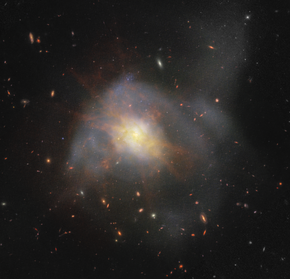Arp 220
| Arp 220 | |
|---|---|
 A combination of James Webb Space Telescope and Hubble Space Telescope data showing a new view infrared galaxy Arp 220 | |
| Observation data (J2000 epoch) | |
| Constellation | Serpens |
| Right ascension | 15h 34m 57.1s[1] |
| Declination | +23° 30′ 11″[1] |
| Redshift | 0.01840±0.00002[1] |
| Heliocentric radial velocity | 5434 ± 7 km/s[1] |
| Apparent magnitude (V) | 13.9[1] |
| Characteristics | |
| Type | S?[1] |
| Size | 33.7 kpc (110,000 ly) |
| Apparent size (V) | 1.5′ × 1.2′[1] |
| Other designations | |
| IC 1127,[1] IC 4553,[1] UGC 9913,[1] PGC 55497[1] | |
Arp 220 is the result of a collision between two galaxies which are now in the process of merging. It is the 220th object in Halton Arp's Atlas of Peculiar Galaxies.
Features
[edit]

Arp 220 is the closest ultraluminous infrared galaxy (ULIRG) to Earth, at 250 million light years away. Its energy output was discovered by IRAS to be dominated by the far-infrared part of the spectrum.[3] It is often regarded as the prototypical ULIRG and has been the subject of much study as a result. Most of its energy output is thought to be the result of a massive burst of star formation, or starburst, probably triggered by the merging of two smaller galaxies. Hubble Space Telescope observations of Arp 220 in 2002 and 1997, taken in visible light with the ACS, and in infrared light with NICMOS, revealed more than 200 huge star clusters in the central part of the galaxy. The most massive of these clusters contains enough material to equal about 10 million suns.[4] X-ray observations by the Chandra and XMM-Newton satellites have shown that Arp 220 probably includes an active galactic nucleus (AGN) at its core, which raises interesting questions about the link between galaxy mergers and AGN, since it is believed that galactic mergers often trigger starbursts, and may also give rise to the supermassive black holes that appear to power AGN.
Luminous far-infrared objects like Arp 220 have been found in surprisingly large numbers by sky surveys of submillimetre wavelengths using instruments such as the Submillimetre Common-User Bolometer Array (SCUBA) at the James Clerk Maxwell Telescope (JCMT). Arp 220 and other relatively local ULIRGs are being studied as equivalents of this kind of object.
Astronomers from the Arecibo Observatory have detected organic molecules in the galaxy.[5]
Arp 220 contains at least two bright maser sources, an OH megamaser, and a water maser.[6] In October 2011, astronomers spotted a record-breaking seven supernova all found at the same time in Arp 220.[7][8] The merging of the two galaxies started around 700 million years ago.[9]
References
[edit]- ^ a b c d e f g h i j k "NASA/IPAC Extragalactic Database". Results for Arp 220. Retrieved 2006-12-07.
- ^ "First Light for Band 5 at ALMA – New receivers improve ALMA's ability to search for water in the Universe". www.eso.org. Retrieved 22 December 2016.
- ^ IRAS exposes a remarkable infrared galaxy , Physics Today, 37, part no 8, 18–20 (1984)
- ^ "Hubble Eyes Star Birth in the Extreme". Retrieved 2006-10-16.
- ^ "Arecibo telescope finds critical ingredients for the soup of life in a galaxy far, far away". Cornell Chronicle. Cornell University. 2008-01-14. Archived from the original on 12 May 2008. Retrieved 2008-04-01.
- ^ "IC 4553". SIMBAD. Centre de données astronomiques de Strasbourg. Retrieved 2006-12-07.
- ^ "Seven Supernovae Found in Single Galaxy – A First" (Press release). Radio Astronomy and Astrophysics Group, National Geographic Society. October 6, 2011. Archived from the original on October 7, 2011. Retrieved October 10, 2011.
we can confirm seven supernovae [in a single galaxy], thanks to a 17-year monitoring of the radio sources in Arp 220
- ^ "Astronomers Reveal Supernova Factory" (Press release). Science Daily. Oct 2, 2011. Archived from the original on 2011-09-30. Retrieved Oct 10, 2011.
With all the data in place, we can now be certain that all seven of these sources are supernovae: stars that exploded in the last 60 years
- ^ United Space in Europe. "Arp 220". www.spacetelescope.org. Retrieved 2017-04-08.
External links
[edit]- "Hubble Sees Star Birth Gone Wild" (SpaceDaily) Jun 16, 2006
- Arp 220 on WikiSky: DSS2, SDSS, GALEX, IRAS, Hydrogen α, X-Ray, Astrophoto, Sky Map, Articles and images
